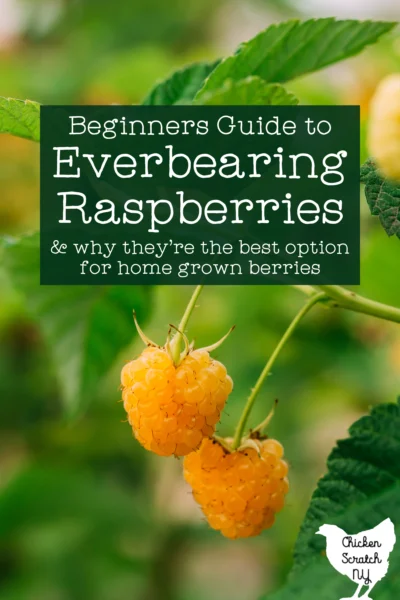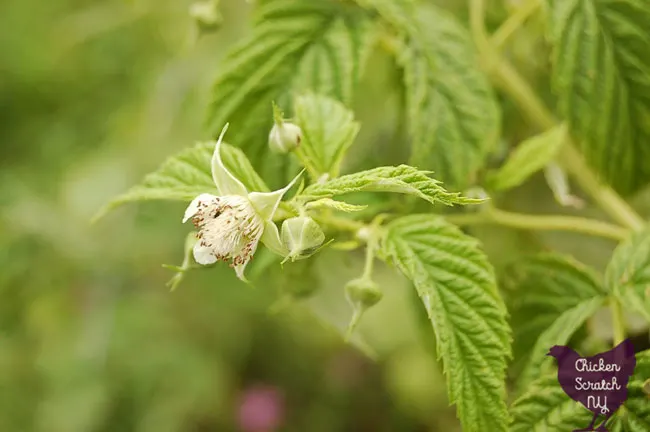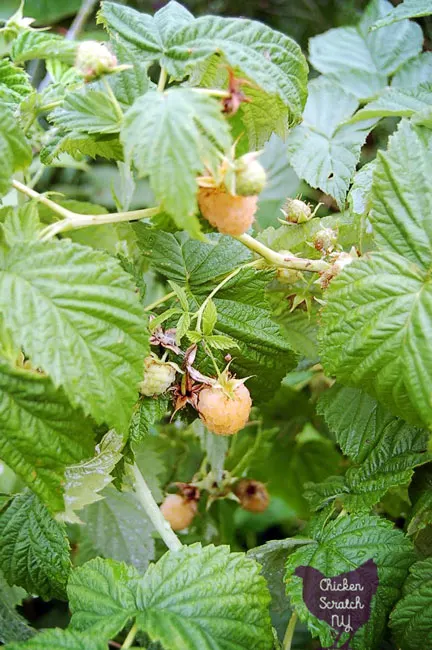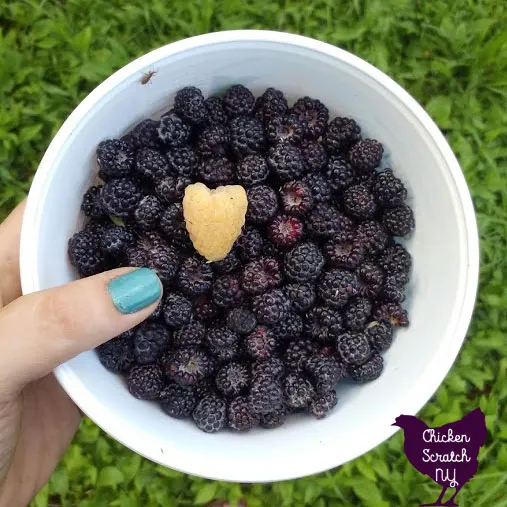Fall-bearing or everbearing raspberries might not as popular as the summer-bearing varieties but they’re the perfect choice for growing fruit at home! The short, sturdy canes promise one (or two) harvests per year no matter how much winter damage the rabbits do!

What are Everbearing Raspberries?
Fall-bearing and ever-bearing raspberries are the same plant, called by two different names. The names actually reflect the two different management strategies you can use to keep your berry patch.
Fall Bearing
The first method, fall-bearing, will give you one big late summer harvest of berries. This is the easiest method and the one I prefer.
You start the growing season with nothing above the ground, canes mowed all the way down, and over the summer the rootstock will send up new canes.
The new canes will flower at the top and that’s where you’ll get your raspberries. I’ve even gotten a few berries off canes planted the same year which almost never happens when growing fruit.

At the end of the season when all the berries are picked you cut everything down. You can even do it with a mower.
It’s great because you don’t have to pay attention to first or second-year canes like with summer bearing raspberries and the clean up could not get any easier.
Raspberries are pretty hands-off once established and I tend to mulch them well and leave them alone to do their thing. The less hand-holding, the better in my book.
It’s also great if you happen to lose most of your canes to winter rabbit damage, you’re still promised a batch of berries!
The downside to this method is you only get single crop of berries. Personally, I don’t mind.
There is enough going on in the summer that I don’t miss an early berry crop but if you aren’t lucky enough to have a bunch of land and room to grow all of the things you can keep your canes around for a second harvest, which brings us to the 2nd method.
Ever Bearing
The everbearing title is a bit overpromising, you’re not getting perpetual raspberries, instead, you’re looking at two distinct harvests.
The early round of berries will come from the canes that grew last year. The canes will grow a new set of flowers below where they fruited last year.
Your second round (the fall harvest) will come from the new canes that grew that year. And then it just repeats, year after year.

If you’re planning to keep your canes for the second year you can cut them off below where they fruited to help keep things neat and compact.
It’s also possible to keep your canes over the winter and cut them back in the early spring if you notice the rabbits have gone to town and done some serious damage (seriously, the rabbits have it out for me).
With either method overtime your bed will get a bit congested. You can always dig out a few canes to make some room and start another berry patch.
Another option is to just cut back some of the thinner canes to make space for the thick ones that will give you more fruit.
How to Plant Everbearing Raspberry Canes
If you’re just getting started the cheapest way to go about it is by ordering and planting bare-root canes in the late winter/early spring.
Some places will sell individually but most will sell in bundles of 3, 5 or ten. If you’ve got the money to pick up more canes go for it but over time raspberries will fill in on their own.
Before your plants arrive you should clear a spot and work in a hefty amount of compost, especially if you’re working in heavy clay or sandy soil.
Everbearing varieties don’t get very tall and will grow perfectly fine without any support.
When it’s time to plant, start by soaking your bare root canes in water for a few hours and then plant about an inch deeper than they were originally grown.
I try to keep the larger roots going in the same direction of the beds so when the plants send up new canes they’re in the beds where I want them and not in the rows between.
Eventually it’s all going to be a chaotic mess but you can keep things tidier by mowing or chopping down any canes that grow where you don’t want them.
Raspberries have shallow roots and your best chance for success is to keep them heavily mulched to thwart competition for weeds and maintain moisture.
Keep in mind that (most) raspberries have thorns and weeding can quickly turn painful!
Fall Bearing Raspberry Varieties
Hopefully, I’ve got you sold on planting some fall-bearing raspberries so let’s talk varieties! At the moment all of my raspberries are either fall-bearing or wild-type black raspberries so I can’t really compare them to summer raspberries but those go in this year so stay tuned!
Heritage
Heritage is the gold standard for ever-bearing raspberries. The sturdy plants are hardy in zones 4-8 and are known for producing heavy crops of red berries, even in the first year after planting.
The first flush (on last year’s canes) ripens in June and the second is ready mid-late season, usually toward to the end of August through frost.
You can expect the medium-sized berries to have good flavor and are good for canning, freezing and of course eating fresh!
Heritage is probably the easiest variety to track down and I’ve seen it for sale in Tractor Supply and similar stores.
Joan J
Joan J is a high-yielding early fall-bearing plant that ripens 10 to 14 days before the Heritage Raspberry. If left to overwinter the 2nd crop is ready in early June.
One thing that makes them stand out is their hornless canes making them a great choice for u-pick or families with young children. The raspberries are large and firm with very good flavor, making them a great choice for shipping and travel.
Polana
Polana is a variety from Poland (go figure) and is very early making them a perfect choice for areas with early frosts. The super hardy canes are even safe down to zone 3.
You can expect medium to large, dark red flavorful berries on short and vigorous canes.
Anne
Anne is a newer variety of gold everbearing raspberry developed in the late 90s. One of the big complaints about Fall Gold is its tendency to crumble, Anne is known for having larger, sturdy berries with a firmer texture better for storage.
Double Gold
Double Gold was developed in NY state at Cornell University. Its stand-out characteristics are the peachy gold color of the berries and an extra sweet flavor.
The canes are slightly less hardy than others and are recommended for zones 5-8. Double Gold is resistant to Phytophthora root rot and most of the common leaf diseases.
Fall Gold
Fall Gold everbearing raspberries were one of the first things I planted when I bought my home. I was so excited to have my own home where I could plant whatever I wanted and my mom couldn’t stop me!!

I’m not sure why I picked gold over red but I have always had a thing for oddly colored fruit, probably why my alpine strawberry adventures started with white berries.
About 3 months after I planted them they were all mowed down in an unfortunate incident with a well-meaning helper.
Fortunately, they were hardy beasts and the next year I was pleasantly surprised to see they had made a comeback. It’s been 10 years since I planted them and I’m still enjoying every single berry.
Occasionally I’ll miss a few canes and end up with an accidental summer flush of berries. This really shows off the size difference in the red/yellow raspberries vs the little black raspberries!
If you have the room and you can get your hands on some Fall Gold raspberries I wholeheartedly recommend you plant them. The berries are large, soft, and so, so sweet.
Their softness means they would never survive a commercial operation, they barely survive the walk into the house (but that may say more about me than it does about the structural integrity of the berries…)
If you’re looking for more information and you love a good chart check out this list of raspberry varieties from Oregon State, they cover more varieties than I’ve ever heard of, and not to toot my own horn but I know more about raspberries than any non-berry farmer should.
Check out my Vegetable Garden page for more ideas or start here:



